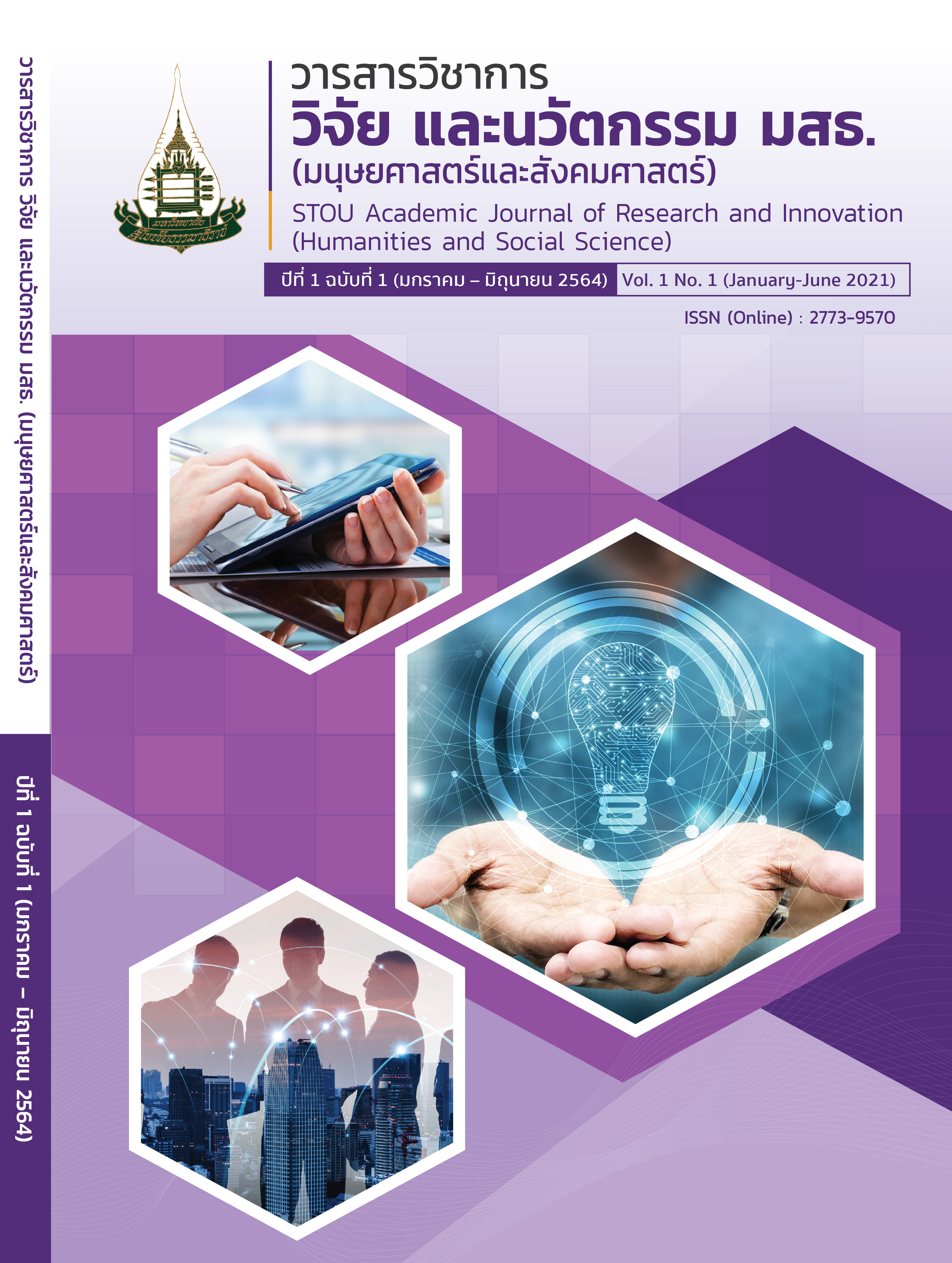สื่อที่ทำให้ความรุนแรงในครอบครัวไทยลดลง
คำสำคัญ:
วิธีปฏิบัติที่ดี, สื่อ, ความรุนแรงลดลง, ครอบครัวบทคัดย่อ
การวิจัยเรื่อง “สื่อที่ทำให้ความรุนแรงในครอบครัวไทยลดลง” มีวัตถุประสงค์ของการวิจัยเพื่อศึกษา “วิธีปฏิบัติที่ดีที่เกี่ยวกับสื่อที่ทำให้ความรุนแรงในครอบครัวไทยลดลง” เป็นการวิจัยเชิงคุณภาพ โดย 1) การถอดบทเรียน “วิธีปฏิบัติที่ดี” (best practices) ที่เกี่ยวข้องกับการใช้สื่ออย่างสร้างสรรค์เพื่อช่วยลดความรุนแรงในครอบครัว 2) การสนทนากลุ่มย่อย (focus group discussion) และ 3) การสัมภาษณ์เชิงลึก จากนั้นวิเคราะห์ด้วยวิธีการพรรณนาความ
ผลการวิจัยพบว่าประเด็นเกี่ยวกับ “วิธีปฏิบัติที่ดี” (best practices) ที่เป็นการถอดบทเรียน การสนทนากลุ่มย่อย (focus group discussion) และ การสัมภาษณ์เชิงลึก ที่เกี่ยวข้องกับสื่อสร้างสรรค์จากทุกภาคส่วนเพื่อช่วยให้ความรุนแรงในครอบครัวไทยลดลง ผลที่ได้พบว่า “วิธีปฏิบัติที่ดี” พบประเด็นที่น่าสนใจคือ ไม่ว่าจะเป็นหน่วยงานประเภทใด เช่น ภาครัฐ องค์กรสื่อ องค์กรสาธารณะประโยชน์ (NGO) ภาคประชาสังคมและภาคประชาชน จะเน้นการทำงานเชิงบูรณาการ ทั้งการบูรณการสื่อที่ใช้ และการบูรณาการการทำงานร่วมกันกับทุกภาคส่วนที่เกี่ยวข้อง และโดยเฉพาะการเปิดกว้างให้ทุกฝ่ายเข้าไปมีส่วนร่วมในการช่วยกันลดความรุนแรงในครอบครัว อีกทั้งการเน้นย้ำเรื่อง การเริ่มเป็นสื่อบุคคลที่ดีด้วยตนเอง ทำหน้าที่ของตนเองในครอบครัว จากนั้นร่วมสอดส่องดูแลป้องกันด้วยการไม่ส่งเสริมการเผยแพร่ หรือสนับสนุนสื่อที่ไม่ดี สื่อที่ไม่เหมาะสม สื่อที่รุนแรงต่าง ๆ อีกทั้งช่วยกันสร้างสรรค์สื่อดี ๆ ออกสู่สังคมร่วมกัน
เอกสารอ้างอิง
กนกพร กระจ่างแสง. (2561). ปัจจัยเชิงสาเหตุที่ส่งผลต่อพฤติกรรมการใช้ความรุนแรงต่อผู้อื่นของวัยรุ่นตอนกลาง. วารสารวิชาการมหาวิทยาลัยธนบุรี, 12(27), น. 97 – 110, จาก https://www.tci-thaijo.org/index.php/trujournal/article/view/110415/ 86585
กมลรัฐ อินทรทัศน์. (2560). เทคโนโลยีสารสนเทศและทฤษฎีการสื่อสาร. สาขานิเทศศาสตร์. มหาวิทยาลัยสุโขทัยธรรมาธิราช, นนทบุรี.
กรมกิจการสตรีและสถาบันครอบครัว กระทรวงการพัฒนาสังคมและความมั่นคงของมนุษย์. (2560). รายงานข้อมูลสถานการณ์ด้านความรุนแรงในครอบครัวตามมาตรา 17 แห่งพระราชบัญญัติคุ้มครองผู้ถูกกระทำด้วยความรุนแรงในครอบครัว พ.ศ.2550 ประจำปี 2559-2560.
กรมกิจการสตรีและสถาบันครอบครัว กระทรวงการพัฒนาสังคมและความมั่นคงของมนุษย์. (2550). พระราชบัญญัติคุ้มครองผู้ถูกกระทำด้วยความรุนแรงในครอบครัว พ.ศ. 2550.
กรมกิจการสตรีและสถาบันครอบครัว กระทรวงการพัฒนาสังคมและความมั่นคงของมนุษย์. (2560). ยุทธศาสตร์การพัฒนาสตรี พ.ศ. 2560-2564.
กรมกิจการสตรีและสถาบันครอบครัว กระทรวงการพัฒนาสังคมและความมั่นคงของมนุษย์. (2562). พระราชบัญญัติส่งเสริมการพัฒนาและคุ้มครองสถาบันครอบครัว พ.ศ.2562.
จะเด็จ เชาวน์วิไล. (2560). สถิติการกระทำความรุนแรงในครอบครัว. มูลนิธิหญิงชายก้าวไกล.
ปิยฉัตร ล้อมชวการ และกมลรัฐ อินทรทัศน์. (2555). “เครื่องมือการรู้เท่าทันสื่อและสารสนเทศ” และ “รู้จักสื่อ รู้ใช้สาร อย่างสร้างสรรค์”. ศูนย์วิจัยการจัดการความรู้การสื่อสารและการพัฒนา (CCDKM). มหาวิทยาลัยสุโขทัยธรรมาธิราช ภายใต้การสนับสนุนของแผนงานสื่อสร้างสุขภาวะเยาวชน (สสย.) สำนักงานกองทุนสนับสนุนการสร้างเสริมสุขภาพ (สสส.).
พิสิษฐ์ โสภณพงศพัฒน์. (2561). ความสัมพันธ์ของสื่อออนไลน์ที่ส่งผลต่อความรุนแรงและการะทำผิดของเด็กและเยาวชนในสถานพินิจและคุ้มครองเด็กและเยาวชนในเขตกรุงเทพและปริมณฑล. จาก http://resource.thaihealth.or.th/library/10924
แรมรุ้ง วรวัธ. (2561). โครงการเร่งด่วน Flagship สังคมไทยไร้ความรุนแรง. กระทรวงการพัฒนาสังคมและความมั่นคงของมนุษย์.
Bandura, A., & Walters, R. (2010). Social Learning Theory. New York: General.
Bazalgette, Cary (2010). Voices of Media Literacy: International Pioneers Speak: Cary Bazelgette Interview Transcript. Interviewer: Dee Morgenthaler. Date: October 13, 2010. Center for Media Literacy. Retrieved from www.medialit.org/sites/.../Voices_of_ML_Cary_Bazalgette.pdf
Boyle, K. (2005). Media and Violence. SAGE Publications.
Brad J. Bushman. (2016). Teaching Students about Violent Media Effects. Retrieved from https://journals.sagepub.com/doi/abs/10.1177/0098628318762936
Bryant, J. & Zillmann, D. (1996). Violence and Sex in Media. An Integrated Approach to Communication Theory and Research. Lawrence Associates Publishers.
Centerwall B. S. (1992). Television and Violence: The Scale of the Problem and Where to Go from Here. Journal of the American Medical Association, 267, pp. 3059- 3063.
Center for Media Literacy. Davis, K. (1962). Human relations at work. New York, NY: McGraw-Hill.
Dowsett, A. & Jackson, M. (2019). The Effect of Violence and Competition within Video Games on Aggression. สืบค้นเมื่อ 30 พฤศจิกายน 2561, จาก https://www.sciencedirect.com/science/article/abs/pii/S0747563219301773
Duncan, B. (2010). Voices of Media Literacy: International Pioneers Speak. Date of interview: May 23, 2010. Interviewer: Dee Morgenthaler, Center for Media Literacy CA:
Galtung. (1990). Cultural Violence. Journal of Peace Research. Retrieved from https://scholar.google.co.th/scholar?q=Galtung.+(1990).+Cultural+Violence.+Journal+of+Peace+Research.&hl= en&as_sdt=0&as_vis=1&oi=scholar
Jill P. Dimond Casey Fiesler Amy S. Bruckman (2011). Domestic Violence and Information Communication Technologies. Retrieved from https://doi.org/10.1016/j.intcom.2011.04.006Get rights and content
Katz, E., Blumler, J. G., & Gurevitch, M. (1973-1974). Uses and Gratifications Research. Public Opinion Quarterly, 37(4), 509-523. Retrieved from https://psycnet.apa.org/record/1974-32398-001
Todd Hunt and Brent d. Ruben. (1993). Mass Communication: Producers and Consumers. Retrieved from https://www.amazon.com/Mass-Communication-Producers-Todd-Hunt/dp/0065000528
Tumaini R.CokerMD (2014). Media Violence Exposure and Physical Aggression in Fifth-Grade Children. Retrieved from https://doi.org/10.1016/j.acap.2014.09.008Get rights and content
UNICEF. (2000). Innocenti Digest No. 6 Domestic Violence against Women and Girls. Retrieved from https://www.unicef-irc.org/media-centre/press-kit/digest6/
UNICEF. (2010). Understanding media: The extensions of man. New York: McGraw-Hill.





